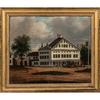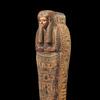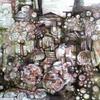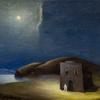Harvard Art Museums Present Fall 2021 Exhibition Devour the Land: War and American Landscape Photography since 1970
- CAMBRIDGE, Massachusetts
- /
- October 04, 2021
This fall, the Harvard Art Museums present the special exhibition Devour the Land: War and American Landscape Photography since 1970, a groundbreaking photographic exploration of the impacts of militarism on the American landscape. Featuring approximately 160 photographs by 60 artists, the exhibition reveals the nationwide footprint of the U.S. military, the wide network of industries that support and supply its work, and the consequences of—and responses to—this activity.
The photographs on display bear witness to a vast geography of environmental damage: millions of acres of land contaminated by nuclear power plants and weapons manufacturing and testing facilities, locations where military waste is actively detonated and burned, decommissioned bases that have been abandoned, and a staggering number of sites across the country that the EPA has declared in urgent need of cleanup (known as Superfund sites). Some of these places have become infamous for health and human welfare issues, such as Cancer Alley, a 150-mile pollution-ridden industrial corridor along the Mississippi River between Baton Rouge and New Orleans. Others are intentionally hidden from view, like the hundreds of prisons that sit within three miles of Superfund sites. Contaminated water and raw sewage from these prisons endanger local communities, which are often rural and poor. In addition, the photographs document the militarization and devastation of Native homelands and the subsequent displacement of Indigenous peoples.
Devour the Land, organized by the Harvard Art Museums, is curated by Makeda Best, the Richard L. Menschel Curator of Photography at the Harvard Art Museums. The exhibition will be on view through January 16, 2022, exclusively at the Harvard Art Museums. An illustrated catalogue accompanies the show. Learn more at harvardartmuseums.org/devourtheland.
“We have devoured the land,” declared Union Army General William Tecumseh Sherman. He was referring to his infamous March to the Sea during the American Civil War (1861–65), for which he instructed troops to “enforce a devastation more or less relentless”—to eliminate the land-based resources and infrastructure that supported the Confederate Army. Sherman was also describing the weaponization of the environment as a means to wage war.
Following a trajectory that originates in the Civil War era, Devour the Land begins with the 1970s and early 1980s, a dynamic period for both environmental activism and landscape photography. American photographers began to rethink the dominant vision of U.S. lands that Ansel Adams had promoted through his collaborations with the Sierra Club, which presented nature as remote, pristine, grandiose, and without inhabitants. For some—including photographers involved in the documentary initiative the Long Island Project, or those featured in the 1975 watershed exhibition New Topographics: Photographs of a Man-Altered Landscape—this meant being attentive to the everyday, including the ways people were connected to (or disconnected from) the land and the environment. For others, it involved taking up a model based in environmental activism and committing to the act of bearing witness.
While continuing to portray the destructive consequences of military activity on American soil, photographers working today also explore how preparations for war and the aftermath can sometimes lead to surprising instances of ecological regeneration and change. Depicting affected regions across the country, their work prompts questions about public oversight, land use and management, human rights, the rights of government, the ethics of technology, and the function of photography as art and as document. Across six thematic sections—Silent Spring, Arming America, Slow Violence, Regeneration, Other Battlefields, and Resistance—the images gathered in the exhibition present a collective portrait of the emergence and expression of these concerns in American photography.
“The military plays a very complicated role in our society, and I want to remind people of what is happening within the land in which we as Americans live and that what we do has consequences,” said curator Makeda Best. “And part of the story is questioning whose land, and whose jobs, and whose lives are expendable, and whose are not. I ask visitors to question how they can put their creative energies toward solving these environmental issues.”
The 60 artists showcased in the exhibition bring a variety of practices and approaches to their work. They range from professional photographic artists and photojournalists to lesser-known and emerging photographers:
Ansel Adams
Robert Adams
Federica Armstrong
Lewis Baltz
Mariona Barkus
George Norman Barnard
Nina Berman
Per Brandin
Sheila Pree Bright
Mima Cataldo
Robert Del Tredici
Terry Evans
Nancy Floyd
Lucas Foglia
Robert Frank
LaToya Ruby Frazier
Andrew Freeman
Sharon Gilbert
Ashley Gilbertson
Peter Goin
Mark Goodman
Emmet Gowin
Joshua Dudley Greer
David T. Hanson
Sebastián Hidalgo
Zig Jackson
Stacy Kranitz
Jin Lee
Freda Leinwand
Kirsten Luce
Dorothy Marder
Elaine Mayes
Dona Ann McAdams
Steve McCurry
Lawrence McFarland
Susan Meiselas
Richard Misrach
Andrew Moore
Ron Morris
Patrick Nagatani
Barbara Norfleet
Timothy H. O’Sullivan
Oscar Palacio
Mark Power
Eli Reed
Jeff Rich
Jack Rodden Studio
Peter Schlessinger
Bryan Schutmaat
Ellen Shub
Sim Chi Yin
Mimi Smith
Joseph Janney Steinmetz
Sharon Stewart
Robert Toedter
Stephen Tourlentes
Phil Underdown
Peter van Agtmael
Alex Webb
Will Wilson
Several of the artists featured in the exhibition share their activism and viewpoints in interviews published in the accompanying catalogue. Others will take part in programming and/or a series of video interviews to be released on the museums’ YouTube channel over the course of the exhibition.
The majority of works on display are drawn from the Harvard Art Museums collections, including many recent acquisitions. Additional works are on loan from other Harvard repositories, North American public institutions, and private collections.
“Together, these images speak to the unexpected and often unknown ways that warfare has transformed the environment over the last half century,” said Martha Tedeschi, the Elizabeth and John Moors Cabot Director of the Harvard Art Museums. “Despite the increasingly urgent threat to the natural world and the fact that our own military holds the unenviable position of being a top polluter, Devour the Land is the first photography exhibition to center this issue. We are grateful to the lenders and artists who have helped us tell this critical story.”
An accompanying installation is also on display in the Lightbox Gallery, an experimental space for digital research and development located on Level 5 of the museums. Using the Lightbox’s large, interactive monitors, visitors can explore in closer detail select portfolios represented in the exhibition: Nina Berman’s Acknowledgment of Danger, Peter Goin’s Nuclear Landscapes Portfolio, David T. Hanson’s Waste Land, and Barbara Norfleet’s The Landscape of the Cold War. A free poster is available in this space for visitors to take home; it overlays a map of the United States with key developments in environmental policy and activism over the last 50 years.
A Spotify playlist spanning nearly nine decades of environmentalism in music extends the experience of the exhibition. The playlist, available through the Harvard Art Museums profile on Spotify (hvrd.art/spotify), features songs by Johnny Cash, Mos Def, Sharon Jones & The Dap-Kings, Xiuhtezcatl, Midnight Oil, and others.
Publication
The accompanying catalogue presents a range of voices at the intersection of art, environmentalism, militarism, photography, and politics, including essays by exhibition curator Makeda Best; Steven Hoelscher, professor of American studies and geography at the University of Texas at Austin and faculty curator of photography in the Harry Ransom Center; Abrahm Lustgarten, senior environmental reporter for ProPublica; Courtney J. Martin, director of the Yale Center for British Art; Katherine Mintie, senior researcher in art history in the Lens Media Lab at Yale’s Institute for the Preservation of Cultural Heritage; and Will Wilson, a Diné photographer and trans-customary artist from the Navajo Nation. The publication is also enhanced by two poems by award-winning poet Ed Roberson and interviews with several of the foremost contemporary artists working in the landscape photography tradition: Sheila Pree Bright, Terry Evans, Ashley Gilbertson, David T. Hanson, Stacy Kranitz, Jin Lee, Richard Misrach, Barbara Norfleet, and Oscar Palacio. Paperback, $50; published by the Harvard Art Museums and distributed by Yale University Press.
Public Programming
The Harvard Art Museums will bring the exhibition to life through a series of free online public programs. All programs will be presented via Zoom. Questions? Email am_register@harvard.edu. For details, updates, and links to register, please see individual listings on our calendar: harvardartmuseums.org/calendar.
On October 5, from 4 to 5pm EDT, artists Terry Evans, Ashley Gilbertson, and Will Wilson—all featured in the exhibition—will gather to discuss their work as documentary photographers and activists in a virtual roundtable moderated by curator Makeda Best. On December 1, from 7 to 8pm EST, Best will dissect wider impacts of military activity in conversation with Neta C. Crawford, a political science professor at Boston University, Catherine Lutz, a professor of international studies and anthropology at Brown University, and Abrahm Lustgarten, an environmental reporter for ProPublica who focuses on the intersection of business, climate, and energy.
The Harvard Film Archive will offer a related program of films this fall—Devour the Land: Cinema, Landscape, History—which expands on the exhibition’s central themes. Curated by Haden Guest, director of the film archive, the program features 14 films (a mix of virtual and in-person screenings) and runs October 8 through December 6. Virtual programs are open to all ($10 general public/free for Harvard affiliates and HFA members). In-person screenings are open only to the Harvard community.
- October 8–11 (streaming): The Annotated Field Guide of Ulysses S. Grant (2020), dir. Jim Finn
- October 16–18 (streaming): O’er the Land (2009), dir. Deborah Stratman; with Visions of an Island (2016), dir. Sky Hopinka
- October 22–25 (streaming): A Land for War (2017), dir. Enid Baxter Ryce
- October 29–November 1 (streaming): California Company Town (2008), dir. Lee Anne Schmitt
- November 5–8 (streaming): still/here (2000), dir. Christopher Harris
- November 12–15 (streaming): Corporate Accountability (Responsabilidad empresarial) (2020), dir. Jonathan Perel
- November 19–22 (streaming) and November 19 & 22 (at HFA): The Airstrip (Airstrip—Aufbruch der Moderne, Teil III) (2014), dir. Heinz Emigholz
- December 3–6 (streaming): Forward Looking Statements (2014), dir. Thomas Kneubühler; with Waste No. 4 New York, New York (2019), dir. Jan Ijäs
- December 3 & 5 (at HFA): Lessons of Darkness (Lektionen in Finsternis) (1992), dir. Werner Herzog
- December 6 & 10 (at HFA): If You Lived Here, You’d Be Home By Now (2001), dir. Diane Bonder; with Deseret (1995), dir. James Benning
- December 11 & 13 (at HFA): Koyaanisqatsi (1982), dir. Godfrey Reggio
Find details about the films, screening times, and more on the HFA website: harvardfilmarchive.org/programs/devour-the-land-cinema-landscape-history.
Credits
This exhibition is made possible in part by the generosity of the Terra Foundation for American Art and The Andy Warhol Foundation for the Visual Arts. Additional support for the project is provided by the Andrew W. Mellon Publication Fund and the Rosenblatt Fund for Postwar American Art. Related programming is supported by the M. Victor Leventritt Lecture Series Endowment Fund. Modern and contemporary art programs at the Harvard Art Museums are made possible in part by generous support from the Emily Rauh Pulitzer and Joseph Pulitzer, Jr., Fund for Modern and Contemporary Art.
The Terra Foundation for American Art supports individuals, organizations, and communities to advance expansive understandings of American art. Established in 1978 and headquartered in Chicago, with an office in Paris, its grant program, collection, and initiatives are committed to fostering cross-cultural dialogues on American art locally, nationally, and internationally. terraamericanart.org
In accordance with Andy Warhol’s will, the mission of The Andy Warhol Foundation for the Visual Arts is the advancement of the visual arts. The foundation manages an innovative and flexible grants program while also preserving Warhol’s legacy through creative and responsible licensing policies and extensive scholarly research for ongoing catalogue raisonné projects. To date, the foundation has given over $218 million in cash grants to over 1,000 arts organizations in 49 states and abroad and has donated 52,786 works of art to 322 institutions worldwide. warholfoundation.org
Contact:
Harvard Art Museums617-496-5331
jennifer_aubin@harvard.edu
32 Quincy Street
Cambridge, Massachusetts
617-495-9400
http://www.harvardartmuseums.org
About Harvard Art Museums
The Harvard Art Museums, among the world’s leading art institutions, comprise three museums (the Fogg, Busch-Reisinger, and Arthur M. Sackler Museums) and four research centers (the Straus Center for Conservation and Technical Studies, the Center for the Technical Study of Modern Art, the Harvard Art Museums Archives, and the Archaeological Exploration of Sardis). The Fogg Museum includes Western art from the Middle Ages to the present; the Busch-Reisinger Museum, unique among North American museums, is dedicated to the study of all modes and periods of art from central and northern Europe, with an emphasis on German-speaking countries; and the Arthur M. Sackler Museum is focused on Asian, ancient, and Islamic and later Indian art. Together, the collections include approximately 250,000 objects in all media. The Harvard Art Museums are distinguished by the range and depth of their collections, their groundbreaking exhibitions, and the original research of their staff. Integral to Harvard University and the wider community, the museums and research centers serve as resources for students, scholars, and the public. For more than a century they have been the nation’s premier training ground for museum professionals and are renowned for their seminal role in developing the discipline of art history in the United States. The Harvard Art Museums’ recent renovation and expansion builds on the legacies of the three museums and unites their remarkable collections under one roof for the first time. Renzo Piano Building Workshop’s responsive design preserved the Fogg Museum’s landmark 1927 facility, while transforming the space to accommodate 21st-century needs. Following a six-year building project, the museums now feature 40 percent more gallery space, an expanded Art Study Center, conservation labs, and classrooms, and a striking new glass roof that bridges the facility’s historic and contemporary architecture. The new Harvard Art Museums’ building is more functional, accessible, spacious, and above all, more transparent. The three constituent museums retain their distinct identities in this new facility, yet their close proximity provides exciting opportunities to experience works of art in a broader context. harvardartmuseums.org






_Infinity_by_Santiago_Medina_PhotoCr100x100_c.jpg)









